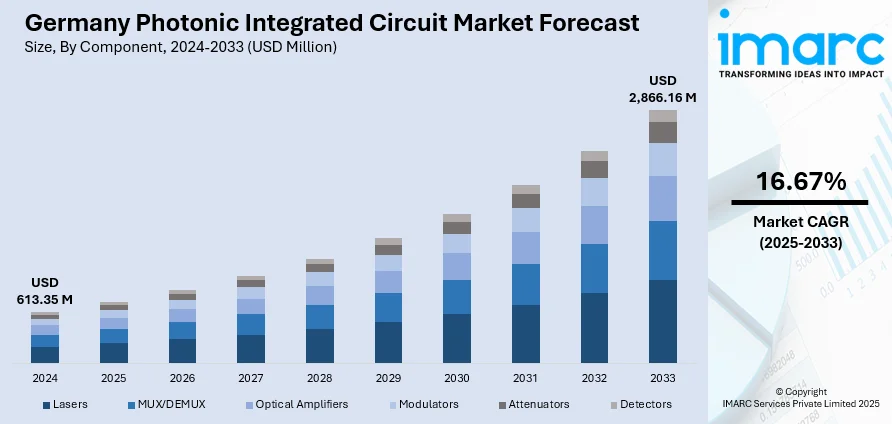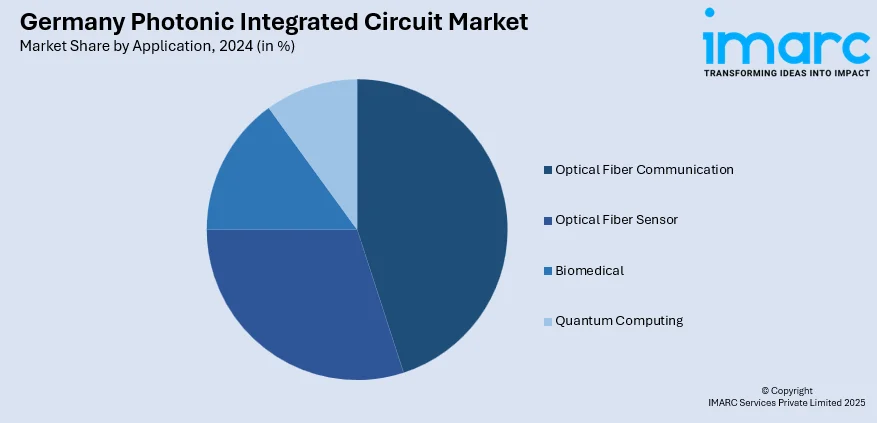
Germany Photonic Integrated Circuit Market Size, Share, Trends and Forecast by Component, Raw Material, Integration, Application, and Region, 2025-2033
Germany Photonic Integrated Circuit Market Overview:
The Germany photonic integrated circuit market size reached USD 613.35 Million in 2024. Looking forward, IMARC Group expects the market to reach USD 2,866.16 Million by 2033, exhibiting a growth rate (CAGR) of 16.67% during 2025-2033. Manufacturing excellence, Industry 4.0 adoption, EU funding for photonics, and demand for optical sensing in automotive and industrial automation sectors drive the market. Academic–industrial synergies spur innovation, with Germany photonic integrated circuit market share stimulated by smart factory deployments and sensor integration.
|
Report Attribute
|
Key Statistics
|
|---|---|
|
Base Year
|
2024
|
|
Forecast Years
|
2025-2033
|
|
Historical Years
|
2019-2024
|
| Market Size in 2024 | USD 613.35 Million |
| Market Forecast in 2033 | USD 2,866.16 Million |
| Market Growth Rate 2025-2033 | 16.67% |
Germany Photonic Integrated Circuit Market Trends:
Industry 4.0 and Smart Manufacturing Integration
Germany’s strong orientation toward Industry 4.0 facilitates integration of photonic ICs within smart manufacturing. Optical sensors and interconnects powered by PICs enhance machine‑to‑machine communication, process monitoring, and predictive maintenance, contributing to Germany photonic integrated circuit market growth. Manufacturers adopt PIC‑based optical modules within factory networks to monitor temperature, strain, and vibration with high precision. Research centers like Fraunhofer institutes collaborate with industrial partners to develop rugged, high‑bandwidth PIC devices suited for harsh manufacturing environments. EU’s photonics flagship programs further fund prototyping and cross‑border testing. As factories seek enhanced automation and real‑time control, PIC tech becomes foundational. This trend exemplifies Germany’s alignment of photonic innovation with its engineering‑driven industrial strategy. For instance, in November 2024, OKI developed an ultracompact photonic integrated circuit chip using silicon photonics, enabling low-power, miniaturized optical sensors for applications like fiber sensing, laser vibrometry, and biosensing. The chip supports mass production, expanding use in infrastructure, healthcare, and communications. It aligns with OKI’s long-term tech strategy focused on energy-efficient sensing and data connectivity for smart, green infrastructure.

To get more information on this market, Request Sample
Environmental Sensing and Mid‑Infrared Applications
Germany is accelerating development of mid‑infrared photonic ICs for environmental monitoring and biomedical sensing. Leveraging its optics and environmental technology strengths, research labs are fabricating PICs tuned to greenhouse‑gas detection and water quality analysis, facilitating Germany photonic integrated circuit market growth. Integrated mid‑IR sources and detectors on a chip enable portable, high‑sensitivity sensing systems. Collaborative EU research projects provide financial and institutional support, accelerating deployment. Germany’s robust ecosystem of analytical instrumentation firms helps move lab‑scale PIC sensors into field‑use applications. As environmental regulation tightens and demand for in‑situ monitoring grows, Germany’s photonic ecosystem is poised to benefit from scalable, sensor‑driven PIC technology in civic and industrial contexts. For instance, in July 2025, Q.ANT deployed its Native Processing Server (NPS), an analog photonic processor, at Germany’s Leibniz Supercomputing Centre (LRZ), marking the first integration of a photonic co-processor in a live HPC environment. The chip enables energy-efficient, high-performance computing for AI, climate modeling, and medical imaging. Offering up to 90x lower power consumption and 100x datacenter capacity, the technology advances sustainable AI infrastructure. Supported by German federal and Bavarian governments, LRZ will evaluate the chip’s real-world performance and scalability.
Germany Photonic Integrated Circuit Market Segmentation:
IMARC Group provides an analysis of the key trends in each segment of the market, along with forecasts at the country and regional levels for 2025-2033. Our report has categorized the market based on component, raw material, integration, and application.
Component Insights:
- Lasers
- MUX/DEMUX
- Optical Amplifiers
- Modulators
- Attenuators
- Detectors
The report has provided a detailed breakup and analysis of the market based on the component. This includes lasers, MUX/DEMUX, optical amplifiers, modulators, attenuators, and detectors.
Raw Material Insights:
- Indium Phosphide (InP)
- Gallium Arsenide (GaAs)
- Lithium Niobate (LiNbO3)
- Silicon
- Silica-on-Silicon
A detailed breakup and analysis of the market based on the raw material have also been provided in the report. This includes indium phosphide (InP), gallium arsenide (GaAs), lithium niobate (LiNbO3), silicon, and silica-on-silicon.
Integration Insights:
- Monolithic Integration
- Hybrid Integration
- Module Integration
The report has provided a detailed breakup and analysis of the market based on the integration. This includes monolithic integration, hybrid integration, and module integration.
Application Insights:

- Optical Fiber Communication
- Optical Fiber Sensor
- Biomedical
- Quantum Computing
A detailed breakup and analysis of the market based on the application have also been provided in the report. This includes optical fiber communication, optical fiber sensor, biomedical, and quantum computing.
Regional Insights:
- Western Germany
- Southern Germany
- Eastern Germany
- Northern Germany
The report has also provided a comprehensive analysis of all the major regional markets, which include Western Germany, Southern Germany, Eastern Germany, and Northern Germany.
Competitive Landscape:
The market research report has also provided a comprehensive analysis of the competitive landscape. Competitive analysis such as market structure, key player positioning, top winning strategies, competitive dashboard, and company evaluation quadrant has been covered in the report. Also, detailed profiles of all major companies have been provided.
Germany Photonic Integrated Circuit Market News:
- In June 2025, Coherent Corp. showcased advanced photonics technologies at Laser World of Photonics 2025 in Munich, presenting innovations across lasers, optics, and medical applications. Highlights included a 600 W excimer laser for HTS tape production, compact medical lasers, and new diode systems. The company also featured thought leadership through keynotes and technical talks, covering topics from industrial laser trends to medical and biophotonics innovations. Coherent emphasized energy efficiency, precision, and OEM integration, reinforcing its role in driving photonics innovation globally.
Germany Photonic Integrated Circuit Market Report Coverage:
| Report Features | Details |
|---|---|
| Base Year of the Analysis | 2024 |
| Historical Period | 2019-2024 |
| Forecast Period | 2025-2033 |
| Units | Million USD |
| Scope of the Report |
Exploration of Historical Trends and Market Outlook, Industry Catalysts and Challenges, Segment-Wise Historical and Future Market Assessment:
|
| Components Covered | Lasers, MUX/DEMUX, Optical Amplifiers, Modulators, Attenuators, Detectors |
| Raw Materials Covered | Indium Phosphide (InP), Gallium Arsenide (GaAs), Lithium Niobate (LiNbO3), Silicon, Silica-on-Silicon |
| Integrations Covered | Monolithic Integration, Hybrid Integration, Module Integration |
| Applications Covered | Optical Fiber Communication, Optical Fiber Sensor, Biomedical, Quantum Computing |
| Regions Covered | Western Germany, Southern Germany, Eastern Germany, Northern Germany |
| Customization Scope | 10% Free Customization |
| Post-Sale Analyst Support | 10-12 Weeks |
| Delivery Format | PDF and Excel through Email (We can also provide the editable version of the report in PPT/Word format on special request) |
Key Questions Answered in This Report:
- How has the Germany photonic integrated circuit market performed so far and how will it perform in the coming years?
- What is the breakup of the Germany photonic integrated circuit market on the basis of component?
- What is the breakup of the Germany photonic integrated circuit market on the basis of raw material?
- What is the breakup of the Germany photonic integrated circuit market on the basis of integration?
- What is the breakup of the Germany photonic integrated circuit market on the basis of application?
- What is the breakup of the Germany photonic integrated circuit market on the basis of region?
- What are the various stages in the value chain of the Germany photonic integrated circuit market?
- What are the key driving factors and challenges in the Germany photonic integrated circuit market?
- What is the structure of the Germany photonic integrated circuit market and who are the key players?
- What is the degree of competition in the Germany photonic integrated circuit market?
Key Benefits for Stakeholders:
- IMARC’s industry report offers a comprehensive quantitative analysis of various market segments, historical and current market trends, market forecasts, and dynamics of the Germany photonic integrated circuit market from 2019-2033.
- The research report provides the latest information on the market drivers, challenges, and opportunities in the Germany photonic integrated circuit market.
- Porter's five forces analysis assist stakeholders in assessing the impact of new entrants, competitive rivalry, supplier power, buyer power, and the threat of substitution. It helps stakeholders to analyze the level of competition within the Germany photonic integrated circuit industry and its attractiveness.
- Competitive landscape allows stakeholders to understand their competitive environment and provides an insight into the current positions of key players in the market.
Need more help?
- Speak to our experienced analysts for insights on the current market scenarios.
- Include additional segments and countries to customize the report as per your requirement.
- Gain an unparalleled competitive advantage in your domain by understanding how to utilize the report and positively impacting your operations and revenue.
- For further assistance, please connect with our analysts.
 Request Customization
Request Customization
 Speak to an Analyst
Speak to an Analyst
 Request Brochure
Request Brochure
 Inquire Before Buying
Inquire Before Buying




.webp)




.webp)












